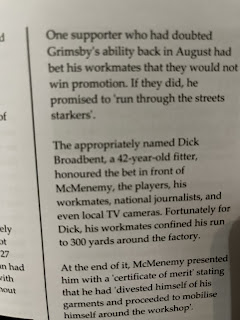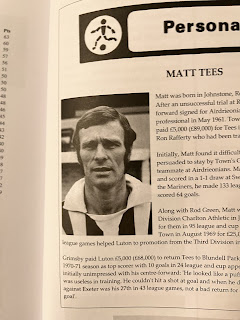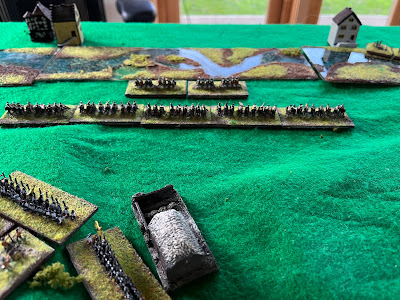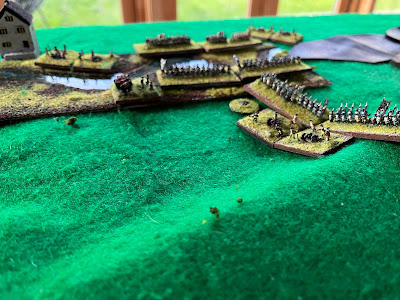The regular reader (hey, you're looking good today) may have noticed that I have an interest in the exploits of Lincolnshire's premier football club. Last season an 18 year obsession with austerity, and downright incompetence off the pitch (and on it to be fair) ended with a second relegation from the Football League in 11 years. The old major shareholder sold up and new brooms swept in, and started to clear up the mess.
Most folk did not expect an immediate return to the FL, and the consensus seemed to be that finishing in the playoffs would be success of a kind. That was achieved the other week, and last Monday saw what the National League calls the Playoff Eliminator. The NL's playoff structure is more complicated than the FL's, but it is fairer to teams that narrowly miss out on automatic promotion. And in the NL's case, there is only one automatic promotion place.
Here's how the season finished (top 8 places only shown - table swiped from the BBC).
The Eliminators saw 5th placed Notts play 6th placed Grimsby (Eliminator A), and 4th placed Halifax play 7th placed Chesterfield (Eliminator B), in one-off matches with the higher placed team having home advantage. Got that? Hmm. Good. Then for the semi-finals, 2nd placed Wrexham played the winner of Eliminator A, and 3rd placed Solihull play the winner of Eliminator B. Again, the higher two teams had home advantage in one-off games. So notionally Grimsby and Chesterfield had the hardest routes to the final, and yep, you guessed it, Wrexham and Solihull had the easiest. All fair.
The Notts game was regarded as something of a free hit. My one hope was that the Town team would just give a good account of themselves on the telly. The home team took the lead, slightly against the run of play, but we can be generous. The Achilles heel of the Grimsby squad was not having a 20 goal striker. County alone had 3 players with more goals than our top striker. But the whole Grimsby squad were immense on the night. They were the better team. Importantly, they played with the head as well as the heart. Nothing rash or rushed. And they fought and fought to equalise, long into the game. 90 minutes came and went with still no equaliser. Five minutes of stoppage time passed. Any of us watching could be forgiven for giving up hope. Personally I felt quite calm throughout, once it was clear our team were giving a good account of themselves. Embarrassment avoided. We can move on. Forget football for the Summer. We'll be back stronger next season.
In the 96th minute County gave away a free kick on the edge of their penalty box. The Grimsby goalkeeper Max Crocombe (Shout out to New Zealand) went up into the County area. The free kick was taken, and during the ensuing scramble, the ball bumbled off Crocombe's leg into the path of Gavan Holohan who banged the ball in.
 |
| Two keepers in the box |
Good business for the quiet South London pub we were in. An extra half hour for half a dozen Northern exiles to slake their thirst. That 30 minutes slipped by and penalties loomed. People began to worry if there were any Germans in the County team. No fear. After 29 minutes of Extra Time the tie was settled. I'm not certain which part of Mani Dieseruvwe's anatomy** knocked the ball into the net, but the record shows a win for the Mariners. In a post match interview the man himself blurted out on TV, 'I've just fucking thrown myself at it'.
** Postscript: Repeated, and I do mean repeated, viewings of the goal on the official BT Sport video failed to reveal the answer. It looked like a hand could have been involved, but the position of the camera from left rear of the striker didn't give a clear view. I later came across a video on YouTube from the point of view of the Notts fans on the right in line with the goal line, or slightly behind it. It looked to me like the ball did hit a hand - but it was the defender's. The defender's left arm was outstretched blocking the path of Dieseruvwe. The momentum of the player moving forward carried the arm with it and the ball with it. Relief!
 |
| What happens when you throw just yourself into something. Sometimes. |
What a team. What spirit.
NEVER SAY DIE!
On to North Wales*. Welsh Wales. I'll leave off the sheep bothering cliches, if you say nothing about fishy smells. On to Wrexham, or as the media call them "Ryan Reynolds' Wrexham". Said Hollywood actor being part-owner alongside the other one. Rob McElhenney? No me, neither. It's got to be Wrexham's year, after 14 or 15 years outside the FL. Having once failed to get promoted with a staggering 98 points, no one would begrudge them promotion. A proper football club. And with the extra £££ rolling in (TikTok shirt sponsorship, Netflix series, etc) they have the money to attract players from League One. Being even more the underdog that in the Notts game, it was an even freer hit(?!) for Town. You know where this is going don't you.
* strictly speaking, on to the same South London pub again for our little band
Let's set out the facts. Look at that league table. 11 points, and a goal difference 23 better than Grimsby. One win apiece in the regular season. Ah, but Wrexham have never won a playoff game. That might not be true, I haven't actually checked. But it's good enough as a 'Football Fact'. Football Fact Number 2 is that since buying a share of the club, Mr McElhenney has not attended a game that Wrexham have won. It's probably not a big sample size, but again it's a Football Fact. Mr McElhenney should probably stay away. For Wrexham's sake.
You knew the result from the preceding paragraph. But just look at the timing. Again!
What a team. What spirit.
NEVER SAY DAI!




































